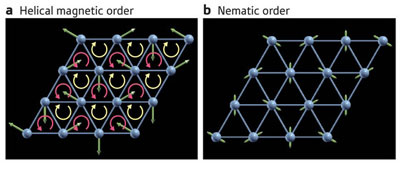| Posted: April 17, 2009 |
Researchers unveil the possible existence of a new magnetic phase in the spatial arrangements of electron spins |
|
(Nanowerk News) RIKEN scientists, in collaboration with researchers at the University of Tokyo, Japan, and Sungkyunkwan University, Korea, have unveiled the possible existence of a new magnetic phase in the spatial arrangements of electron spins ("Nematic and Chiral Order for Planar Spins on a Triangular Lattice"). The new arrangement is considered to be the combination of two unconventional types of order.
|
|
Spin, in this context, is the smallest magnetic moment associated with an electron and can point in any direction. In most solid structures, the spins of electrons sitting on different atoms will tend to point in such a way that neighboring spins point in opposite, or ‘anti-parallel’ directions. This gives rise to the so-called antiferromagnetic phase. There are, however, some atomic structures for which this is not possible, and they are called geometrically frustrated structures. Triangular lattices, including the compounds κ-(BEDT-TTF)2Cu2(CN)3 and NiGa2S4, are common examples of geometrically frustrated structures.
|
|
As team-member Shigeki Onoda from the RIKEN Advanced Science Institute in Wako explains, the spins interact among themselves and with the natural vibration of the lattice. This combined interaction can give rise to unusual types of order. One example is the helical order (Fig. 1a), in which spins rotate with respect to one another, but in an ordered way. The helical order is a type of chiral order: as in all chiral systems, it cannot be superimposed on its mirror image. Another example is the nematic order (Fig. 1b) in which the orientation angle of the spins is fixed, but keep flipping their direction.
|
 |
| Schematic representation of (a) helical and (b) nematic order in a triangular spin lattice.
|
|
The researchers studied theoretically the phase diagram of a triangular lattice in which spins can point in any direction in the plane. The mutual interaction between spins has two components: one that is usually responsible for the emergence of helical order, and one that leads to nematic order. Until now, however, no-one had considered the combination of both.
|
|
The team’s calculations show interesting results in the case in which the nematic component is predominant. When the temperature rises—increasing the lattice vibrations—the helical order is replaced by a new chiral phase, in which the spins flip in time, similar to the nematic case. According to Onoda, this chiral–nematic order could be used in applications. The chirality allows rotating the polarization of a transmitted laser beam. By varying the external conditions, such as external fields, pressure, or temperature, it could be possible to switch the chirality—and the polarization rotation—on and off, effectively creating a functional optical device.
|

